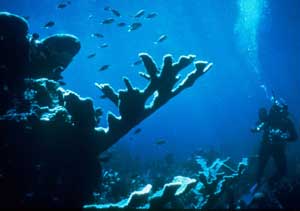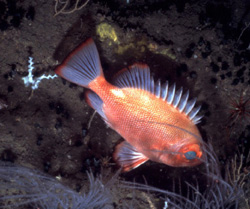|
Using
Physical Oceanography: How Water Moves
 Imagine
that you are stranded on a desert island less than 100 miles from shore.
You write a message, stuff it into a bottle, and toss it into the ocean.
Do you know what the chances are that a floating message in a bottle will
be found? Theyíre not bad -- you actually have about a 50% chance that the
bottle will be carried by the ocean to land. The ocean is a constantly
moving force that influences our global climate, provides routes for
ships, and creates fascinating challenges and movements that we are just
beginning to understand. Imagine
that you are stranded on a desert island less than 100 miles from shore.
You write a message, stuff it into a bottle, and toss it into the ocean.
Do you know what the chances are that a floating message in a bottle will
be found? Theyíre not bad -- you actually have about a 50% chance that the
bottle will be carried by the ocean to land. The ocean is a constantly
moving force that influences our global climate, provides routes for
ships, and creates fascinating challenges and movements that we are just
beginning to understand.
The ocean moves in many ways;
tides, waves, and currents arenít the only forces at work in the ocean.
Eddies, gyres, deep currents, and rings provide circulation patterns that
make each Outer
Continental Shelf (OCS) region of the Minerals Management Service
(MMS)
 unique.
After 30 years of funding
scientific
studies, the MMS has found that, although some characteristics,
such as the response of currents to wind forcing, are common to many
continental shelves, the relative importance of various physical processes
in influencing the shelf varies from region to region. unique.
After 30 years of funding
scientific
studies, the MMS has found that, although some characteristics,
such as the response of currents to wind forcing, are common to many
continental shelves, the relative importance of various physical processes
in influencing the shelf varies from region to region.
Researchers use many different
methods to measure the oceanís moving forces. Drifters, which are
instruments that move with the water and record location, have long been
used by oceanographers like a message in a bottle to discover and study
ocean currents. Technological advances have led to important discoveries.
Through the use of satellite imagery, specialized moorings, and acoustic
techniques, researchers have gained vital information used to model and
predict the oceanís movements.
 The
physical oceanography research supported by MMS provides information used
in oil-spill trajectory analyses, discharge models, larval dispersal, and
engineering designs for platforms. These studies directly support MMS
management decisions and are useful in the review of development and
production plans and oil-spill contingency plans. The
physical oceanography research supported by MMS provides information used
in oil-spill trajectory analyses, discharge models, larval dispersal, and
engineering designs for platforms. These studies directly support MMS
management decisions and are useful in the review of development and
production plans and oil-spill contingency plans.
The need to balance the value of
OCS resources against the potential for environmental damage is an
important concern for MMS. As offshore activities expand into new
geographic areas such as the deep waters of the
Gulf of Mexico, an
understanding of the complete dynamic environment of the ocean will play a
major role in MMSís management of these ocean resources.
MMS Ocean Science Journal
Home | Search |
Topic Index |
About MMS |
What's New
|
Director's
Page | Strategic
Planning | Minerals Revenue |
Offshore Program |
Newsroom |
Congressional Affairs | Advisory
Committees | Library |
Information Quality Guidelines |
FOIA |
Kids' Page |
Privacy Act/Disclaimers |
Links |
Products &
Services | Job Opportunities
|
Navigation Tips |
Contact Us |
Deepwater
Environment | Industry
Awards |
Royalty-In-Kind
| Oil Valuation |
EEO Data - No FEAR Act
Last Updated:
10/13/2004,
01:25 PM Central
Time

|

